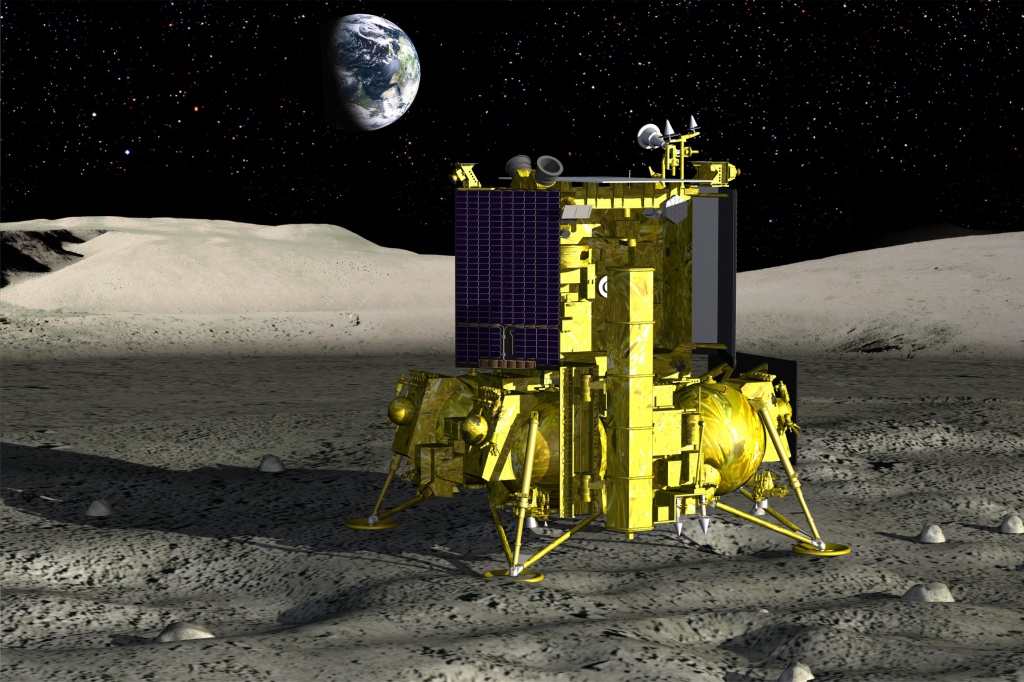Russia wants to land 3 next-generation Luna spacecraft on the moon by 2025

Russia hasn't been to the moon since 1976, but the country hopes to soon pick up where it left off.
The nation has a suite of three moon missions planned for the first half of this decade, and Vladimir Kolmykov, head of the Lavochkin Scientific and Production Association, the segment of Russian space agency Roscosmos that oversees interplanetary robots, recently spoke about the program's current state. The missions will pick up where the Soviet space program left off in the 1970s, with the new spacecraft dubbed Luna-25, Luna-26 and Luna-27, all of which represent partnerships with the European Space Agency (ESA).
"The Luna-25 spacecraft is currently in the assembly and first trial stages," Kolmykov told President Vladimir Putin, according to an English transcription of the call posted by the Kremlin on April 10. "Yes, there are some cooperation problems but we are working on them. I hope that the 2021 goal of launching Luna-25 will be achieved."
Related: NASA lunar orbiter spots old Soviet moon landers
According to a conversion with Kolmykov posted to the Roscosmos website on April 14, the Luna-25 spacecraft should be completed next March and the space agency is currently targeting a launch date of Oct. 1, 2021. (ESA is contributing a video camera and ground-station support for the mission, he noted.)
Later this decade, Luna-26 will map the moon's surface and Luna-27 will study the lunar regolith, the rock and dust that cover the moon's surface, after landing with a European piloting system. "Overall we are fairly confident that the objectives involving Luna-26 and Luna-27 will be met in 2024 and 2025, respectively," Kolmykov told Putin during the meeting last month.
More missions are under consideration as well. Luna-28 could carry a small rover and send moon rocks back to Earth; Luna-29 could carry a larger rover along the lines of the Soviet Lunokhod vehicles.
Get the Space.com Newsletter
Breaking space news, the latest updates on rocket launches, skywatching events and more!
The moon is a popular destination these days. The U.S., which originally raced to the moon with the Soviet Union in the 1950s, '60s and '70s, is aiming to return robots to the lunar surface starting in 2021 as part of its Artemis program to land astronauts at the south pole in 2024. China's Chang'e-4 lander has spent more than a year studying the far side of the moon with a companion rover, and the nation has a suite of additional missions in the works, with Chang'e-5 scheduled to launch later this year.
Of course, not every moon mission succeeds. Last year, two landers — the Beresheet mission from Israel and the landed portion of India's Chandrayaan-2 mission — crashed into the lunar surface.
Kolmykov is confident the new Russian missions won't meet the same fate, he said in the Roscosmos interview. The touchdown process for the Luna landers is modeled on the previous Soviet spacecraft and Roscosmos is not currently exchanging knowledge with Israel or India, he said.
- China releases huge batch of amazing Chang'e-4 images from moon's far side
- This is the last photo Israel's Beresheet moon lander ever took
- India's Chandrayaan-2 spacecraft scouts the moon in new lunar photos
Email Meghan Bartels at mbartels@space.com or follow her @meghanbartels. Follow us on Twitter @Spacedotcom and on Facebook.
OFFER: Save 45% on 'All About Space' 'How it Works' and 'All About History'!
For a limited time, you can take out a digital subscription to any of our best-selling science magazines for just $2.38 per month, or 45% off the standard price for the first three months.
Join our Space Forums to keep talking space on the latest missions, night sky and more! And if you have a news tip, correction or comment, let us know at: community@space.com.

Meghan is a senior writer at Space.com and has more than five years' experience as a science journalist based in New York City. She joined Space.com in July 2018, with previous writing published in outlets including Newsweek and Audubon. Meghan earned an MA in science journalism from New York University and a BA in classics from Georgetown University, and in her free time she enjoys reading and visiting museums. Follow her on Twitter at @meghanbartels.
-
Lovethrust I wish they would go back to Venus and pick up where they left of there. They were very successful.Reply -
sunstance I really want the international space station to be retro fitted and sent to the moon as the first moon base. it really serves no purpose at the moment. it doe snot have the design specification to be able to run tests in things like artificial gravity in its design. there should be massive development in these areas as the suns spectral phases is orange only red is left we need to start making plans to be able to transfer our lives into space as part of growing up and moving out.Reply -
JPL-ACE It seems like every few months that Russia comes out with a new plan or rocket that on paper is better than any western device or program. And they never get off the paper. Their income is something like 75% from oil and on a good day, pays the rent. Just. Rusian scientists are very smart but they have nothing to work with. sad.Reply -
sunstance united federation of states isn't it. or similar. having no money is the best lace right now, plenty time to work out designs and the technology we need is already really know in most areas. in science right now the sad truth is observation is not being used to the full extent of those who came before us. and technology has blinded many a good scientist to directions they may not provide accurate finding relevant to the answer.Reply










